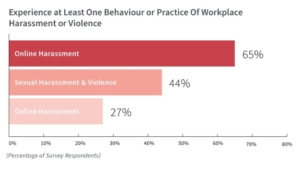Do We Have A Bully Problem?
Today, Minister of Labour, Seamus O’Regan Jr., announced the launch of the 2022 Call for Concepts for the Workplace Harassment and Violence Prevention Fund, which aims to guide culture change around harassment and violence in federally regulated workplaces. The fund provides $3.5 million annually to projects aimed at creating safer workplaces for employees and helping workplaces comply with Bill C-65, federal harassment and violence prevention legislation. (Source)
Encouraging and Discouraging
This news isn’t all that great. While it may be helpful for the government to ask other professionals and idea people to contribute to solutions around bullying in the workplace, the announcement says it all; despite all the previous legislation, policy alone won’t stop rude, demeaning, and violent behavior. The solution starts from some internal pivot. Can we find the courage as a society to face our responsibility for where we are and do something constructive about it?
Any intelligent fool can make things bigger, more complex, and more violent. It takes a touch of genius – and lots of courage to move in the opposite direction.” ~ E.F. Shcumacher
The Stats Are Telling
Perhaps a not-so-surprising survey study was released this spring from the National Survey on Harassment and Violence at Work in Canada. The results of their online survey, which collected 4878 responses, reveal the need for an honest assessment of the issue.
We focus on so many personal development topics at Fiore Group Training because the solution to workplace bullying includes personal responsibility and the adoption of our commitment to improving our social behaviors and our policies. Of course, we highly encourage policy and procedure, but it starts with me. How do I behave on a bad day? No excuses.
Borrowing this image from the University of Western Ontario

Union Membership Not A Protection
The statistics show that those at the highest risk are those who work with the public, especially in pharmacies or with alcohol, handling cash, working nights, or in remote locations. Still, surprisingly, a significant number reported workplace bullying and threats of violence while doing online work, completely secluded from the public. Did it help to belong to a union? Not really, as 87.8% of respondents were union members and 86% were in permanent work situations.
Social Divisions a Contributing Factor
Of course, we aren’t experts in social behavior. Nevertheless, you and I might surmise that daily reporting in the news and social media of political and social divides, each side blaming the other for the problems we all face, contributes to a growing sense of anxiety – even fear.
When human beings operate habitually from fear, our perspectives and behaviors are reactionary, desperate – slanted toward self-preservation.
“Pernicious polarization” refers to the “us versus them mindset” and has been studied for decades as a challenge to democracies worldwide. From our workplace perspective, the same problem and outcomes apply. How can we create a happy and productive workplace if the people who work there are not rooted in their inner core values?
We Need People Asking New Questions
“PAT” answers are just that Pat Closed Done.
We need more – a new approach using ancient methods: questions And not just any old questions – good questions. The only way to arrive at new solutions is to ask new and thoughtful questions – we need fresh insight.
- So what can we do as leaders in the workplace?
- How can we use our platforms to nourish respectful behavior in ourselves and our employees?
- Can we prosper and achieve our business objectives for the next decade if we “ride along and see how she goes?”
- Is it critical to your organizational success to maintain long-tenured employees who enjoy where they work and how their work affects their well-being?
Your Turn
Keep adding questions to the list. Meet with your colleagues and keep asking questions. Don’t be hasty to answer them. Avoid “PAT.”






